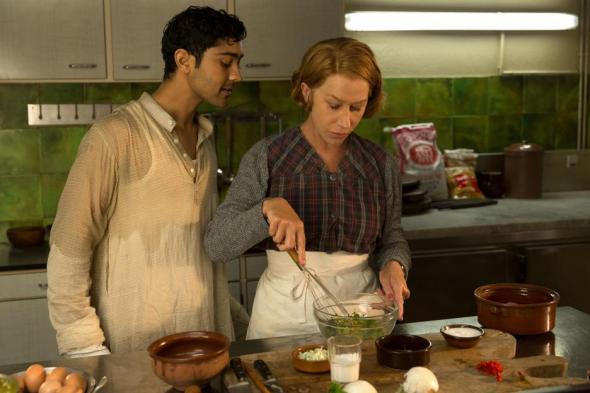Like Chocolat, Lasse Hallström’s previous movie about French food, The Hundred-Foot Journey is something of a fairy tale. It takes place in a universe where every fruit and vegetable is deeply colored and perfectly shaped, where beautiful women not only stop to help you when you’re having car trouble but also take you home and feed you cheese, where French people speak English to one another in French accents, where ruthless competition and mutual distrust are just smokescreens for true love. It’s unrealistic, in other words. It’s also totally charming, thanks in large part to the appeal of lead actors Manish Dayal and Charlotte Le Bon (whose asymmetrical teeth, wry speaking cadence, and nervous energy remind me of Julie Delpy). The food helps, too—no one shoots a hollandaise like Hallström.
But as beautiful and mouthwatering as The Hundred-Foot Journey’s cooking scenes are, they convey an odd message when taken together. The film presents an absurd view of professional cooking, in which technique is irrelevant, inferior, and counterproductive to inspiration. (Spoilers follow, although not much happens in this movie that you can’t see coming a mile away.)
The Hundred-Foot Journey, based on the novel by Richard C. Morais, tells the story of Hassan Kadam (Dayal), a young Indian man who moves to the South of France with his headstrong father (Om Puri) and four siblings. Hassan learned how to cook from his late mother at their family restaurant in India, but he has no formal culinary training. The Kadams open a new restaurant across the street from a Michelin-starred French restaurant run by Madame Mallory (Helen Mirren, doing a French-accented riff on her character from The Queen). As Hassan wins over the locals with his flawless Indian cooking, he also takes an interest in learning more about la cuisine classique by way of flirting with Marguerite (Le Bon), a sous-chef at Madame Mallory’s restaurant.
This storyline could set up all sorts of uncomfortable implications about the sophistication of French culture vis-à-vis Indian culture, but The Hundred-Foot Journey takes pains to assure the audience that it is not down with Orientalism. Perhaps as a safeguard against accusations of French chauvinism, Hallström insists that Hassan is a culinary prodigy in spite of his lack of classical training. A turning point arrives when Hassan auditions for a stage in Madame Mallory’s restaurant by cooking her an omelet. (The old idea that you can tell a chef’s quality based on his omelet will be familiar to any Top Chef fan.) What’s extraordinary about the scene is that Hassan’s hands are thoroughly bandaged up, thanks to a misfortune that has recently befallen him, so instead of actually cooking the omelet for Madame Mallory, he tells her how to cook it according to his specifications. Based on the omelet that she has made according to Hassan’s instructions, Madame Mallory concludes that he has “it”—the ineffable quality that makes a great chef.
Even for a fairy tale, this turn of events feels off. Knowing a good omelet recipe is one thing; being able to execute it precisely, efficiently, and consistently in a professional kitchen is something entirely different. Any rational restaurateur, Michelin-starred or not, would take one look at a job applicant with bandaged hands and say, “Come back when your hands are better.” But in The Hundred-Foot Journey, the acts of breaking eggs, whisking them, and cooking them are unimportant—Hassan’s talent, we are meant to believe, transcends the physical act of cooking.
In fact, focusing too much on the physical act of cooking is a bad thing, according to The Hundred-Foot Journey. To the extent that the film has a villain (apart from a stereotypically snooty French chef who is vanquished within the first hour of the movie), it’s molecular gastronomy, the technique-intensive, chemistry-focused discipline made famous by Ferran Adrià at El Bulli. After Hassan gains national recognition cooking at Madame Mallory’s restaurant (within months of starting his stage), he climbs the professional ladder to a chic modernist restaurant in Paris, whose owner lures Hassan with the promise that his establishment pursues “innovation, innovation, innovation.” However, cooking experimental, critically acclaimed dishes like shellacked beets and cauliflower ice cream, Hassan is unhappy. (We know this because he starts drinking a lot more often than he did when he was hanging out with Marguerite.) Molecular gastronomy doesn’t fulfill him the way classical Indian and French cooking did—pipettes, flasks, and other lab equipment kill the joy of cooking, the film implies. If you let technique take center stage, the result is soulless food.
Granted, some people do actually feel that molecular gastronomy is soulless, and the idea that spirit is separate from and superior to the material world is as old as Plato. But The Hundred-Foot Journey’s insistence on pitting inspiration against technique—even suggesting that culinary inspiration can take place without technique—represents a fundamental misunderstanding of what chefs do. Dicing, emulsifying, and sautéing (or dehydrating, flash-freezing, and spherifying, for that matter) are not dangerous knowledge that threaten the soul of cuisine—they’re the palette chefs use to make their art. Cooking is inherently physical work. How could it not be, when the results are meant to be put in our bodies?
The notion that a great chef can express his greatness by telling someone else how to make an omelet makes about as much sense as the notion that a painter could prove her talent by telling someone else how to paint a still life. The idea of a great dish, independent of ingredients and labor, is just that: an idea, not a sign of pure genius.
